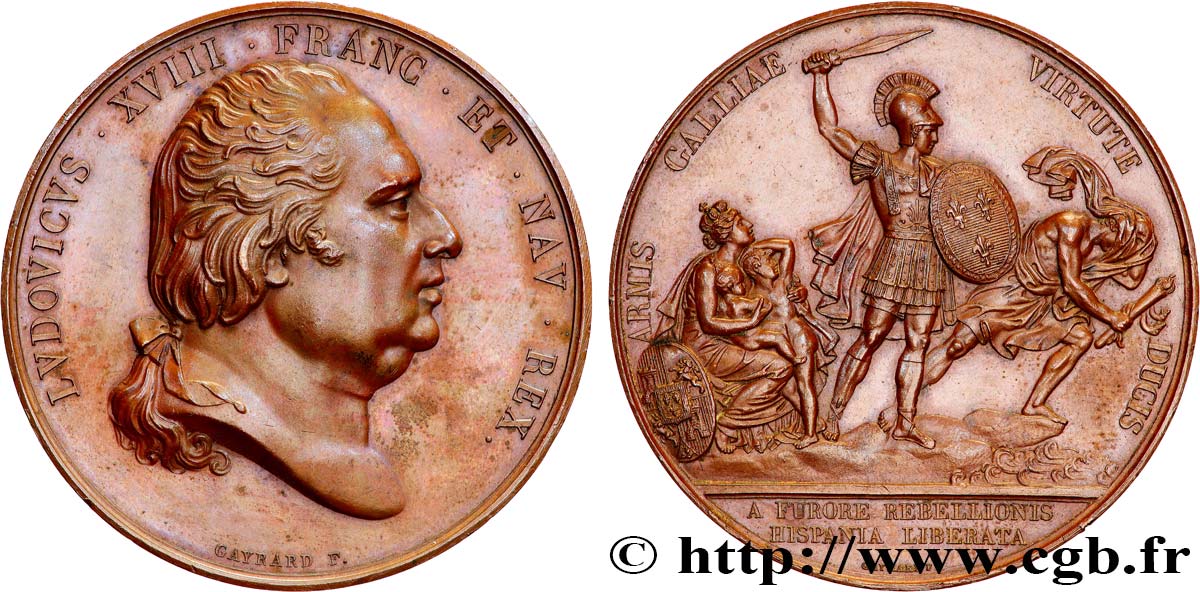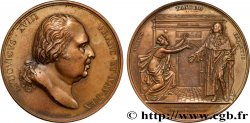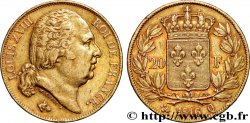fme_814301 - LOUIS XVIII Médaille, Restauration du trône d’Espagne
95.00 €约 795.15 CNY
数量
加入购物车

种类 Médaille, Restauration du trône d’Espagne
日期: 1823
材质 copper
直径 50,5 mm
模子方针 12 h.
硬币制模工 GAYRARD Raymond (1777-1858)
重量 71,06 g.
侧面 Lisse
印模 sans poinçon
关于品相的说明
Jolie patine marron, quelques marques d’usure sur les reliefs. Présence de quelques coups sur la tranche en particulier à 5 heures au revers
出版目录中的项代码 :
正面
正面的文字 LVDOVICVS. XVIII. FRANC. ET. NAV. REX..
正面的说明书 Tête de Louis XVIII à droite, signé : GAYRARD F..
背面
背面的文字 ARMIS GALLIAE - VIRTUTE - DUCIS // A FURORE REBELLIONIS / HISPANIA LIBERATA.
背面的说明书 Guerrier debout vêtu à l'antique brandissant le glaive, le bouclier timbré de trois lys, repoussant l'ennemi vers la mer ; à gauche, l'Espagne assise retenant deux enfants, à ses pieds un bouclier timbré aux armes de Castille et de Léon. Signé : GAYRARD F..
评论
La restauration absolutiste en Espagne est la période de l'histoire d'Espagne s'étendant entre 1814 et 1833, au cours de laquelle le pays connaît un rétablissement de la monarchie absolue des Bourbons.
Après la guerre d'indépendance contre l'occupant français, les Cortès se réunissent à Madrid en octobre 1813. Peu après, Napoléon reconnaît Ferdinand VII comme roi d'Espagne par le traité de Valençay. Fort du soutien de la majeure partie de la population espagnole, celui-ci rentre dans sa capitale, le 22 mars 1814, par le chemin de Valence. Il reçoit alors, de la main d'un groupe de fidèles de la monarchie, le manifeste des Perses, une déclaration favorable à une restauration absolutiste.
Début 1823, la Sainte Alliance décide d'intervenir en Espagne, ainsi qu'elle l'a déjà fait à Naples et au Piémont. Le 22 janvier un traité secret est signé qui permet à la France d'envahir l'Espagne pour rétablir Ferdinand VII en monarque absolu.
.
The absolutist restoration in Spain was the period in Spanish history between 1814 and 1833, during which the country experienced a reestablishment of the absolute Bourbon monarchy. After the War of Independence against the French occupiers, the Cortes met in Madrid in October 1813. Shortly after, Napoleon recognized Ferdinand VII as King of Spain by the Treaty of Valençay. With the support of most of the Spanish population, he returned to his capital on March 22, 1814, via Valencia. He then received, from a group of monarchy loyalists, the Persian Manifesto, a declaration in favor of an absolutist restoration. In early 1823, the Holy Alliance decided to intervene in Spain, as it had already done in Naples and Piedmont. On January 22, a secret treaty was signed that allowed France to invade Spain and reinstate Ferdinand VII as absolute monarch.
Après la guerre d'indépendance contre l'occupant français, les Cortès se réunissent à Madrid en octobre 1813. Peu après, Napoléon reconnaît Ferdinand VII comme roi d'Espagne par le traité de Valençay. Fort du soutien de la majeure partie de la population espagnole, celui-ci rentre dans sa capitale, le 22 mars 1814, par le chemin de Valence. Il reçoit alors, de la main d'un groupe de fidèles de la monarchie, le manifeste des Perses, une déclaration favorable à une restauration absolutiste.
Début 1823, la Sainte Alliance décide d'intervenir en Espagne, ainsi qu'elle l'a déjà fait à Naples et au Piémont. Le 22 janvier un traité secret est signé qui permet à la France d'envahir l'Espagne pour rétablir Ferdinand VII en monarque absolu.
.
The absolutist restoration in Spain was the period in Spanish history between 1814 and 1833, during which the country experienced a reestablishment of the absolute Bourbon monarchy. After the War of Independence against the French occupiers, the Cortes met in Madrid in October 1813. Shortly after, Napoleon recognized Ferdinand VII as King of Spain by the Treaty of Valençay. With the support of most of the Spanish population, he returned to his capital on March 22, 1814, via Valencia. He then received, from a group of monarchy loyalists, the Persian Manifesto, a declaration in favor of an absolutist restoration. In early 1823, the Holy Alliance decided to intervene in Spain, as it had already done in Naples and Piedmont. On January 22, a secret treaty was signed that allowed France to invade Spain and reinstate Ferdinand VII as absolute monarch.








 对产品描述纠错
对产品描述纠错 打印
打印 分享我的选择
分享我的选择 提问
提问 Consign / sell
Consign / sell
 产品介绍
产品介绍










